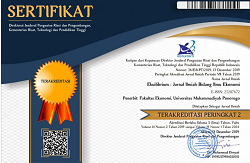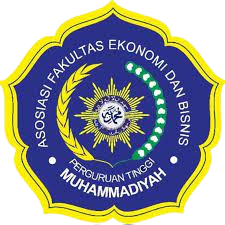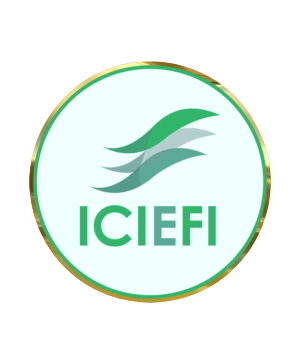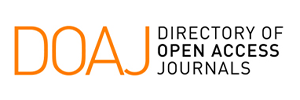Poverty Rates and the Factors Influencing Poverty Alleviation: A Case Study in the Province of West Kalimantan, Indonesia
DOI:
https://doi.org/10.24269/ekuilibrium.v17i1.2022.pp23-39Abstract
There is a trend of decreasing the poverty rate in Indonesia. But in the Province of West Kalimantan, there are still five districts with poverty rates that are above the average national rate, namely Melawi, Landak, Ketapang, Sintang, and North Kayong districts. The purpose of this study is to estimate the relationship between government transfers which are proxied by the amount of GAT (General Allocation Transfer) Funds, economic growth, and the quality of human resources in terms of education and health which are proxied by the average years of schooling and public-health insurance membership. Once these factors can be identified, it is hoped that the government will find it easier to reduce poverty levels. Based on Nested Test, model that passes the goodness of fit test is The Common Effect model so this model is used in estimating and interpreting in this research. It shows that there is no difference in the behavior of the research variables, either between time or between individuals. The findings of this study that the economic growth variable is not significant in reducing the poverty level, the variable of literacy level have a significantly negative effect on the poverty level, the variable of public-health insurance membership has significantly positive on the poverty level, and the central government transfer variable proxied by GAT has significantly positive effect significant to the poverty level.
References
Adji, A. &Rakhmad, S.H. (2017). Indonesia Poverty Reduction Strategies: Shifting Policies to Promote Employment in the Poorest Four Deciles. Economics and Finance in Indonesia, Vol 63, No. 1, 13-37.
Akbar, M.R.H. (2013). Analisis Determinan Ekonomi Korupsi di Era Desentralisasi pada 12 Ibu kota Provinsi Indonesia. Jurnal Ilmiah Mahasiswa FEB, 1(2). https://jimfeb.ub.ac.id/index.php/jimfeb/article/view/612
Anan, E. (2012). DesentralisasiFiskal dan Tingkat Korupsi di Indonesia. EBBANK, 3(2), 371–382. http://ebbank.stiebbank.ac.id/index.php/EBBANK/article/view/50
Anan, F &Ravallion, M. (1993). Human Development in Poor Countries: On the Role of Private Incomes and Public Services. Journal of Economics Perspectives, 7(1), 133-150. http://DOI.10.1257/jep.7.1.133
Arsani, A., Ario, B., & Ramadhan, A. (2020). Impact of Education on Poverty and Health: Evidence from Indonesia. Economics Development Analysis Journal, 9 (1), 87-96. https://doi.org/10.15294/edaj.v9i1.34921
Awan, M., Malik. N., Sarwar, H., & Waqas, M. (2011). Impact of Education on Poverty Reduction. International Journal of Academic Research, Vol.3, Part II, 659-664.
Baskaran, T & Feld, L. (2013). Fiscal Decentralization and Economic Growth in OECD Countries Is there a relationship? Public Finance Review, 41 (4), 421- 445.
Canare, T. & Francisco, J.P. (2019). Decentralization, Fiscal Independence, and Poverty in the Philippines. Public Budgeting and Finance, Vol 39, Issue 4, Winter, 94-117. https://doi.org/10.1111/pbaf.12241
Cao, Q., Ewing, B.T., & Thompson, M.A. (2012). Forecasting medical cost inflation rates: A model comparison approach. Decis Support Syst., 53 (1), 154-60. https://doi.org/10.1016/j.dss.2011.12.012
Central Bureau of Statistics. (2017, 2020). Indonesia Dalam Angka.
Central Bureau of Statistics. (2020). Berita Resmi StatistikNomer 56/07/Tahun XXIII, 15 Juli. Retrieved from https://voi.id/en/economy/37805/causes-of-poverty-definitions-and-data-on-the-poor-in-indonesia
Charlesworth, A. (2014). Why is health care inflation greater than general inflation? J Health Serv Res Policy. 19(3), 129-30 https://doi.org/10.1177%2F1355819614531940
Cooray, A., Kumar, S., & Queen, M. (2011). What Explains Cross-Country Growth in South Asia? Female Education and the Growth Effect of International Openness (No. 145; Issue June 2014).
Dana Desa untuk Kalimantan Barat. (2020). Retrieved from https://pontianak.tribunnews.com/2019/11/16/dana-desa-untuk-kalimantan-barat-tahun-2020-mencapai-rp-2042-triliun
Didu, S., & Fauzi, F. (2016). Pengaruh Jumlah Penduduk, Pendidikan dan Pertumbuhan Ekonomi Terhadap Kemiskinan di Kabupaten Lebak. Jurnal Ilmu Ekonomi, 6 (1), 100-114.
Fahroez, A.F., & Sihaloho, E.D. (2018). Pengaruh Penderita Penyakit, Kemiskinan, Dan Pengangguran di Indonesia Terhadap Permintaan BPJS Kesehatan. Jurnal Ekonomi, 2(1), 8-18.
Fosu, A. K. (2011). Growth, inequality, and poverty reduction in developing countries, Working Paper No. 2011/01, UNU-WIDER.
Fatoni, A. (2018). Fiscal Decentralization Dilemma in Indonesia: Between Corruption Accountability and Probability at Local Levels. Jurnal Bina Praja, 12 (1), 103-112. DOI: 10.21787/jbp.12.2020,101-110
Green, M.J., Stritzel, H., & Smith, C. (2018). Timing of poverty in childhood and adolescent health: Evidence from the US and UK. Social Science & Medicine, Vol 197, 136-143. https://doi.org/10.1016/j.socscimed.2017.12.004
Grossman, M. (1972). The Demand for Health: A Theoretical and Empirical Investigation. National Bureau of Economic Research and Columbia University Press. New York.
Harjanto, J.T. & Astuti, E.S. (2017). Analysis for corruption and decentralization (Case study: earlier decentralization era in Indonesia). Jurnal Perspektif Pembiayaan dan Pembangunan Daerah, Vol. 4. No. 4, April – June, 2338-4603.
Hartanto, R., &Probohudono, A.N. (2013). Desentralisasi Fiskal, Karakteristik Pemerintah Daerah dan Tingkat Korupsi Pemerintah Daerah pada Tahun 2008 dan 2010. Proceeding Simposium Nasional Akuntansi XVI Manado.
Haughton, J. &Khandker, S.R. (2012). Pedoman Tentang Kemiskinan dan Ketimpangan. Jakarta: Salemba Empat.
Hudáková, J. (2017). Relationship Between Gross Domestic Product and Human Development Index. The Proceeding of 4th International Multidisciplinary Scientific Conferences on Social Sciences & Arts SGEM.
Isufaj, M. (2014). Decentralization and The Increased Autonomy in Local Governments. Procedia Social and Behavioral Science, Vol 109, 8 January, 459-463. https://doi.org/10.1016/j.sbspro.2013.12.490
Joinson, C., Daphne, K., & Glyn, L. (2016). Family socioeconomic position in early life and onset of depressive symptoms and depression: a prospective cohort study. Soc. Psychiatry Psychiatric Epidemiol, 52, 95 -103. http://DOI.10.1007/s00127-016-1308-2
Jouini, N., Lustig, N., Moummi, A., & Shimeles, A. (2018). Fiscal Policy, Income Redistribution, and Poverty Reduction: Evidence from Tunisia. The Review of Income and Wealth, Vol 64 (1), 225 - 248. https://doi.org/10.1111/roiw.12372
Julius, M.K., &Bawane, J. (2011). Education and Poverty, Relationship and Concerns. A Case for Kenya. Problems of education in the 21st century, Vol 32, 72-85.
Khullar, D., & Chokshi, D.A. (2018). Health, Income & Poverty. Health Affairs, October 4, Retrieved from https://www.healthaffairs.org/do/10.1377/hpb20180817.901935/full/
Magombeyi, M.T. & Odhiambo, N.M. (2017). Poverty dynamics in Botswana: Policies, trends, and challenges. Cogent Social Sciences, 3, 1-12. http://DOI:10.1080/23311886.2017.1329246
Majid, A. (2014). Strategi Pembelajaran. Bandung: PT RemajaRosdakarya.
Malay, D.S. (2011). Payments for surgical services and the medical inflation rate. J Foot Ankle Surg, 50(1), 74 -76. https://doi.org/10.1053/j.jfas.2010.11.001
Massardi, R., Adji, A., &Pradiptyo, R. (2014). The Effect of Medical Test to Belief Updating and Willingness to Pay for Health Insurance Premium: Evidence from Laboratory Experiment. The Open Public Health Journal, Vol 10, 2017, 41-51. https://benthamopen.com/contents/pdf/TOPHJ/TOPHJ-10-41.pdf
Mukharjee, K. (2015). Poverty as a cause and consequence of Ill Health. International Journal of Epidemiologic Research, Vol 2(4), 209 - 220.
Mulok, D., Kogid, M., Asid, R., & Lily, J. (2012). Is economic growth sufficient for poverty alleviation? Empirical evidence from Malaysia. Cuadernos de Economia, 35(97), 26-32. http://dx.doi.org/10.1016/S0210-0266(12)70020-1
Nursini, N. &Tawakkal. (2019). Poverty alleviation in the context of fiscal decentralization in Indonesia. Economics and Sociology, 12(1), 270-285. https://doi.10.14254/2071-789X.2019/12-1/16
Rao, M.G., & Das-Gupta, A. (1995). Intergovernmental Transfers and Poverty Alleviation: Environment and Planning. Government and Policy, Vol. 13, No. 1, 1-23.
Remler, D.K., Korenman, S.D., & Hyson, R.T. (2017). Estimating The Effects Of Health Insurance And Other Social Programs On Poverty Under The Affordable Care Act. Health Affairs, Vol. 36, NO. 10. https://doi.org/10.1377/hlthaff.2017.0331
Reza, F., & Widodo, T. (2013). The Impact of Education on Economic Growth in Indonesia. Journal of Indonesian Economy and Business, 28(1), 23–44.
Rismawati. (2015). Pelayanan BPJS Masyarakat di Puskesmas Karang Asam Kecamatan Sungai Kunjang Kota Samarinda. Jurnal ilmu Administrasi Negara, 3 (5), 1668-1682.
Rodriguez, L. & Wai-Poi, M. (2021). Fiscal Policy, Poverty and Inequality in Jordan: The Role of Taxes and Public Spending. Policy Summary of World Bank Report.https://www.worldbank.org/en/country/jordan/publication/fiscal-policy-poverty-and-inequality-in-jordan-the-role-of-taxes-and-public-spending
Rodriguez-Pose, A. & Hardy, D. (2015). Poverty and Inequality in the Rural Economy from a Global. Applied Geography, Vol 5, 1-13.
Saputra, B., & Mahmudi, M. (2012). Pengaru DesentralisasI Fiskal terhadap Pertumbuhan Ekonomi dan Kesejahteraan Masyarakat. Jurnal Akuntansi& Auditing Indonesia, 16 (2), 185–199.
Sarker, A.E. & Rahman, M.H. (2014). The Role of Social Accountability in Poverty Alleviation Programs in Developing Countries: An Analysis with Reference to Bangladesh. Public Organization Review, Vol 14, Issue 1, http://DOI:10.1007/s11115-014-0275-x
Shrestha, R. (2021). Health Insurance for the Poor, Healthcare Use and Health Outcomes in Indonesia. Bulletin of Indonesian Economies Studies, Vol 57, Issue 1, 85-110.
Singh, P.K., & Chudasama, H. (2020). Evaluating poverty alleviation strategies in a developing country. PLoS ONE, 15(1): e0227176. https://doi.org/10.1371/journal.pone.0227176
Stryzhak, O. (2020). The relationship between education, income, economic freedom and happiness. SHS Web of Conferences 75, 03004. https://doi.org/10.1051/shsconf/20207503004.
Skare, M. &Druzeta, R.P. (2016). Poverty and Economic Growth. Technological and Economic Development of Economy, 22(1), 156-175.
Thapa, B.S. (2013). Relationship Between Education and Poverty in Nepal. Economic Journal of Development Issues, Vol. 15, No. 1,148-161.
Wardhana, D. (2019). Decentralization, Democratization, And Social Protection In Indonesia: A Systematic Review of the Literature. The Indonesian Journal of Development Planning Volume III No. 2 – August, 164-184.
Wherry, L., Kenney, M., & Sommer, B.D. (2016). The Role of Public Health Insurance in Reducing Child Poverty. AcadPediatr, Apr; 16(3 Suppl): 98–104. http://DOI.10.1016/j.acap.2015.12.011
Yushkof, A. (2015). Fiscal Decentralization and Regional Economic Growth: Theory, Empirics, and Russian Experience. Russian Journal of Economics, Vol 1, 404-418. https://doi.org/10.1016/j.ruje.2016.02.004
Zaman, K. & Khilji, B.A. (2013). The relationship between the growth-inequality-poverty triangle and pro-poor growth policies in Pakistan: the twin disappointments. Economic Modelling, 30, 375-393. http://dx.doi.org/10.1016/j.econmod.2012.09.023
Rao, G.M. (2004). Poverty Alleviation under Fiscal Decentralization. Retrieved from http://www1.worldbank.org/publicsector/decentralization/March2004Course/PovertyAlleviation.pdf at March 31, 2021.
Syahroni. (2018). Angka Kemiskinan Kalbar Tertinggi Sekalimantan. Retrieved from http://pontianak.tribunnews.4com/2018/09/25/berdasarkan-angka-bps-angka-kemiskinan-kalbar-tertinggi-se-kalimantan
Downloads
Published
How to Cite
Issue
Section
License
Retained Rights/Terms and Conditions of Publication
1. As an author you (or your employer or institution) may do the following:
- make copies (print or electronic) of the article for your own personal use, including for your own classroom teaching use;
- make copies and distribute such copies (including through e-mail) of the article to research colleagues, for the personal use by such colleagues (but not commercially or systematically, e.g. via an e-mail list or list server);
- present the article at a meeting or conference and to distribute copies of the article to the delegates attending such meeting;
- for your employer, if the article is a ‘work for hire’, made within the scope of your employment, your employer may use all or part of the information in the article for other intra-company use (e.g. training);
- retain patent and trademark rights and rights to any process, procedure, or article of manufacture described in the article;
- include the article in full or in part in a thesis or dissertation (provided that this is not to be published commercially);
- use the article or any part thereof in a printed compilation of your works, such as collected writings or lecture notes (subsequent to publication of the article in the journal); and prepare other derivative works, to extend the article into book-length form, or to otherwise re-use portions or excerpts in other works, with full acknowledgement of its original publication in the journal;
- may reproduce or authorize others to reproduce the article, material extracted from the article, or derivative works for the author's personal use or for company use, provided that the source and the copyright notice are indicated, the copies are not used in any way that implies RCEPM-LIPI endorsement of a product or service of any employer, and the copies themselves are not offered for sale.
All copies, print or electronic, or other use of the paper or article must include the appropriate bibliographic citation for the article's publication in the journal.
2. Requests from third parties
Although authors are permitted to re-use all or portions of the article in other works, this does not include granting third-party requests for reprinting, republishing, or other types of re-use. Requests for all uses not included above, including the authorization of third parties to reproduce or otherwise use all or part of the article.
3. Author Online Use
- Personal Servers. Authors and/or their employers shall have the right to post the accepted version of articles pre-print version of the article, or revised personal version of the final text of the article (to reflect changes made in the peer review and editing process) on their own personal servers or the servers of their institutions or employers without permission from Universitas Muhamamdiyah Ponorogo, provided that the posted version includes a prominently displayed Universitas Muhamamdiyah Ponorogo copyright notice and, when published, a full citation to the original publication, including a link to the article abstract in the journal homepage. Authors shall not post the final, published versions of their papers;
- Classroom or Internal Training Use. An author is expressly permitted to post any portion of the accepted version of his/her own articles on the author's personal web site or the servers of the author's institution or company in connection with the author's teaching, training, or work responsibilities, provided that the appropriate copyright, credit, and reuse notices appear prominently with the posted material. Examples of permitted uses are lecture materials, course packs, e-reserves, conference presentations, or in-house training courses;
- Electronic Preprints. Before submitting an article to an Ekuilibrium: Jurnal Ilmiah Bidang Ilmu Ekonomi, authors frequently post their manuscripts to their own web site, their employer's site, or to another server that invites constructive comment from colleagues. Upon submission of an article to Ekuilibrium: Jurnal Ilmiah Bidang Ilmu Ekonomi, an author is required to transfer copyright in the article to Economy Faculty Universitas Muhammadiyah Ponorogo, and the author must update any previously posted version of the article with a prominently displayed Economy Faculty Universitas Muhammadiyah Ponorogo copyright notice. Upon publication of an article by the Universitas Muhammadiyah Ponorogo, the author must replace any previously posted electronic versions of the article with either (1) the full citation to the work with a Digital Object Identifier (DOI) or link to the article abstract in Ekuilibrium: Jurnal Ilmiah Bidang Ilmu Ekonomi journal homepage, or (2) the accepted version only (not the final, published version), including the Economy Faculty Universitas Muhammadiyah Ponorogo copyright notice and full citation, with a link to the final, published article in journal homepage.
4. Articles in Press (AiP) service
Economy Faculty Universitas Muhammadiyah Ponorogo may choose to publish an abstract or portions of the paper before we publish it in the journal. Please contact our Production department immediately if you do not want us to make any such prior publication for any reason, including disclosure of a patentable invention.
5. Author/Employer Rights
If you are employed and prepared the article on a subject within the scope of your employment, the copyright in the article belongs to your employer as a work-for-hire. In that case, Economy Faculty Universitas Muhammadiyah Ponorogo assumes that when you sign this Form, you are authorized to do so by your employer and that your employer has consented to the transfer of copyright, to the representation and warranty of publication rights, and to all other terms and conditions of this Form. If such authorization and consent has not been given to you, an authorized representative of your employer should sign this Form as the Author.
6. RCEPM-LIPI Copyright Ownership
It is the formal policy of Economy Faculty Universitas Muhammadiyah Ponorogo to own the copyrights to all copyrightable material in its technical publications and to the individual contributions contained therein, in order to protect the interests of the Economy Faculty Universitas Muhammadiyah Ponorogo, its authors and their employers, and, at the same time, to facilitate the appropriate re-use of this material by others. Economy Faculty Universitas Muhammadiyah Ponorogo distributes its technical publications throughout the world and does so by various means such as hard copy, microfiche, microfilm, and electronic media. It also abstracts and may translate its publications, and articles contained therein, for inclusion in various compendiums, collective works, databases and similar publication.
7. Licensing Terms
Ekuilibrium is licensed under a Creative Commons Attribution-ShareAlike 4.0 International License.
Permissions beyond the scope of this license may be available at https://journal.umpo.ac.id/













